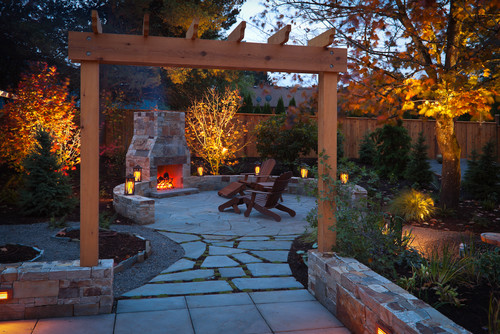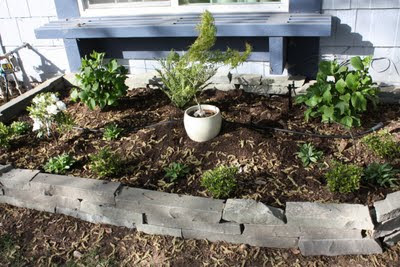Temperatures in Northern California finally cooled off into the upper 90s making it possible to devote some of my weekend hours to finishing one of the first main projects at my new house. All that remains of this project is to think of a name for this part of the garden. Why is that gardeners have a need to assign names?
I have spent the last decade watching
Gardening by the Yard,
Yard Crashers and the innumerable
P. Allen Smith shows. I have read garden design books, books about specific types of plants, and books about the lives of gardeners. I have read, subscribed to, and written blog posts about gardening. And all that information, all that time and energy has led me to this point. In my new garden, I feel as if I have to prove that I actually learned something and that I can apply it to my own life. What good is knowledge otherwise?
With that in mind, here are some of the lessons I have learned and how I applied them to this project:
I waited a couple months before I even tackled this project. I stood at the window in the house and just looked at this corner of the yard and wondered what it would look like if I did X, Y, or Z. I checked the sunlight at different times of day. I went back to the window and imagined some more. When it came time to break ground I did one thing at a time and then I stopped and went back to the window and lived it with it some more. From start to finish, this project took 5 or 6 weeks to complete as a result.
 |
| The view of the new bed from our patio |
Lesson – Take your time and do it right
Most of this area was grass. There was an
Aristocrat Pear tree and an Oleander that had to go as well. I dug all these out by hand and with the help of a new “
Mr. Diggy” (heartfelt thanks to Calvin). Then I put in the drip irrigation lines because nothing non-native will grow here without supplemental watering. And then I went back to waiting. I waited for the grass I missed to show itself again and when it did, I dug it out with my
hori hori (best garden tool I own). That left me with a bare patch of dirt for a while and I ached to get it planted, but I knew that if I got ahead of myself I could spend a lifetime weeding unwanted grass and that it would be so much easier to do it now with nothing in the way and nothing to disturb.
Lesson – Curved beds look better
My wife doesn’t often offer up comments on my gardening. She sees it as my realm. She’ll comment and compliment when I show things off to her but for the most part she lets me do whatever I want and is learning to trust that I have some kind of vision for things. But after I carved the outline for this bed she broke from tradition and told me “I like the shape of that new bed.”
Lesson – Paths don’t have to be made of stone
I’ve always loved stone pathways. But stone is expensive and it’s labor intensive to install. Plus, there’s the added and ongoing chore of weeding the cracks between the stones. This time, I’m letting the lawn be the pathway. Besides, a green lawn when used as a foil to the rest of the garden can be quite charming. Check out these pictures I added to my "Grass Pathways" ideabook on Houzz.com:
Lesson – Repetition
When I go for a walk or take a drive and notice other people’s gardens I am almost always drawn to the gardens that use repetition in their plants. There’s something wonderful about a garden filled with ferns or large patches of ornamental grasses. And yet, when it comes to my own garden I have always wanted to use as many different plants as I could get my hands on. There are hundreds of Japanese maple cultivars so how in the world is a gardener supposed to live with just one? But in this case, I really did try to limit my plant selection. I used mondo grass along the border and punctuated the garden with Japanese blood grass. From there, I pretty much broke the rules though. I planted a Baby Blue Spruce, a Snow Fountains Weeping Cherry, a Jubilee blueberry bush, a Mr. Lincoln rose that was given to me last month, and a Black & Blue Sage. Even along the symmetrical trellises, a natural place for repetition, I failed. I planted a climbing Iceberg rose on the right but planted jasmine on the left because . . .
 |
| I love the way Japanese Blood Grass (Imperata cylindrica) catches the sunlight. |
Lesson – Never plant thorny things where people walk
I really wanted a climbing rose to grown up this shed. It would have looked awesome to have two climbing roses growing up over the window. But I remember how annoying it was to walk under the arbors at my last house and get my hat or my shirt sleeve stuck on a thorn. So I planted jasmine on the trellis near the pathway because it is easily trimmed and it won’t wave a thorny fist in my face when I walk past it.
 |
| Non-thorny jasmine on the left |
 |
| Me So Thorny rose on the right |
Lesson – Plants will grow
In my gardening life the times when I have been most pleased with something I have done was initially after I finished planting. I arranged the small little plants just so and I stand back and congratulate myself on having an aesthetic eye. And then the plants grow up and things don’t look like they used to. Why I neglect to conceive of a plant’s ultimate size is beyond me. Perhaps because I didn’t have the experience of watching them grow to maturity? This time around I did my best to leave room for things to grow. As a consequence, there is a whole lot of mulch being used as ground cover right now but I think that in a year or two, much of the mulch will be composting in place and the plants and trees will be filling in. If not, I can always buy more plants to fill the spaces.






















































